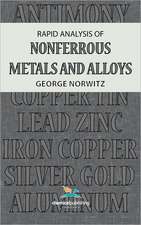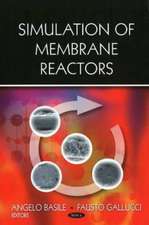Current Trends and Future Developments on (Bio-) Membranes: Modern Approaches in Membrane Technology for Gas Separation and Water Treatment
Editat de Angelo Basile, Evangelos P. Favvasen Limba Engleză Paperback – 21 noi 2023
Finally, the book describes and discusses three novel ideas about the potential effect of the magnetic field on membrane separation efficiency, the use of cryogenic technology on membrane separations, and the use of nanobubble technology on water membrane processes.
- Focuses on the necessity for environmental-friendly and cost-effective purification and separation process
- Lists all new membrane materials suitable for commercialization
- Presents new modern approaches and ideas for improving the membrane efficiency
| Toate formatele și edițiile | Preț | Express |
|---|---|---|
| Paperback (2) | 1051.03 lei 5-7 săpt. | |
| ELSEVIER SCIENCE – 21 noi 2023 | 1051.03 lei 5-7 săpt. | |
| ELSEVIER SCIENCE – 20 iul 2018 | 1168.15 lei 5-7 săpt. |
Preț: 1051.03 lei
Preț vechi: 1373.52 lei
-23% Nou
Puncte Express: 1577
Preț estimativ în valută:
201.13€ • 208.72$ • 168.12£
201.13€ • 208.72$ • 168.12£
Carte tipărită la comandă
Livrare economică 10-24 martie
Preluare comenzi: 021 569.72.76
Specificații
ISBN-13: 9780323993111
ISBN-10: 0323993117
Pagini: 574
Dimensiuni: 191 x 235 mm
Greutate: 0.98 kg
Editura: ELSEVIER SCIENCE
ISBN-10: 0323993117
Pagini: 574
Dimensiuni: 191 x 235 mm
Greutate: 0.98 kg
Editura: ELSEVIER SCIENCE
Cuprins
Part 1 New, promising to be commercialized, membrane
materials and units
1. Review on polymeric membrane materials for gas separations which are
stated above the Robeson’s trade-off upper bound
2. New inorganic membranes for gas separations which are stated above the
Robeson’s trade-off upper bound
3. New nonporous fillers-based hybrid membranes for gas separations and water
treatment process
4. New commercial membranes for gas separations and water desalination
processes
Part 2 New membrane manufacturing materials
5. New metal-organic frameworks and other porous filler-based hybrid
membranes for gas separation and wastewater treatment
6. Polymers of intrinsic microporosity and their applicability in pilot-scale
membrane units
7. SiC porous membranes. How possible could be the production of
high selective porous SiC membranes?
8. Carbon and graphene oxide materials and their potential applications in
membrane separation technology
9. Solvent and material selection for greener membrane manufacturing
10. New polymeric and inorganic membrane materials for water separation
Part 3 The next decade’s ideas about the future
membrane technology
11. Hybrid membranes, liquid/solid, for the enhancement of membrane gas
selectivity. The example of ionic liquid membrane
12. Cryogenic-membrane gas separation hybrid processes
13. New perspectives in gas separations (CO2/CH4, H2/CH4) using membranes
14. New perspectives in O2/N2 gas separation
15. Recent advances in the application of magnetic/electromagnetic
field for water desalination
16. Applications of graphene oxide in reverse osmosis membranes
17. Membrane water processes and nanobubble technology
materials and units
1. Review on polymeric membrane materials for gas separations which are
stated above the Robeson’s trade-off upper bound
2. New inorganic membranes for gas separations which are stated above the
Robeson’s trade-off upper bound
3. New nonporous fillers-based hybrid membranes for gas separations and water
treatment process
4. New commercial membranes for gas separations and water desalination
processes
Part 2 New membrane manufacturing materials
5. New metal-organic frameworks and other porous filler-based hybrid
membranes for gas separation and wastewater treatment
6. Polymers of intrinsic microporosity and their applicability in pilot-scale
membrane units
7. SiC porous membranes. How possible could be the production of
high selective porous SiC membranes?
8. Carbon and graphene oxide materials and their potential applications in
membrane separation technology
9. Solvent and material selection for greener membrane manufacturing
10. New polymeric and inorganic membrane materials for water separation
Part 3 The next decade’s ideas about the future
membrane technology
11. Hybrid membranes, liquid/solid, for the enhancement of membrane gas
selectivity. The example of ionic liquid membrane
12. Cryogenic-membrane gas separation hybrid processes
13. New perspectives in gas separations (CO2/CH4, H2/CH4) using membranes
14. New perspectives in O2/N2 gas separation
15. Recent advances in the application of magnetic/electromagnetic
field for water desalination
16. Applications of graphene oxide in reverse osmosis membranes
17. Membrane water processes and nanobubble technology





















